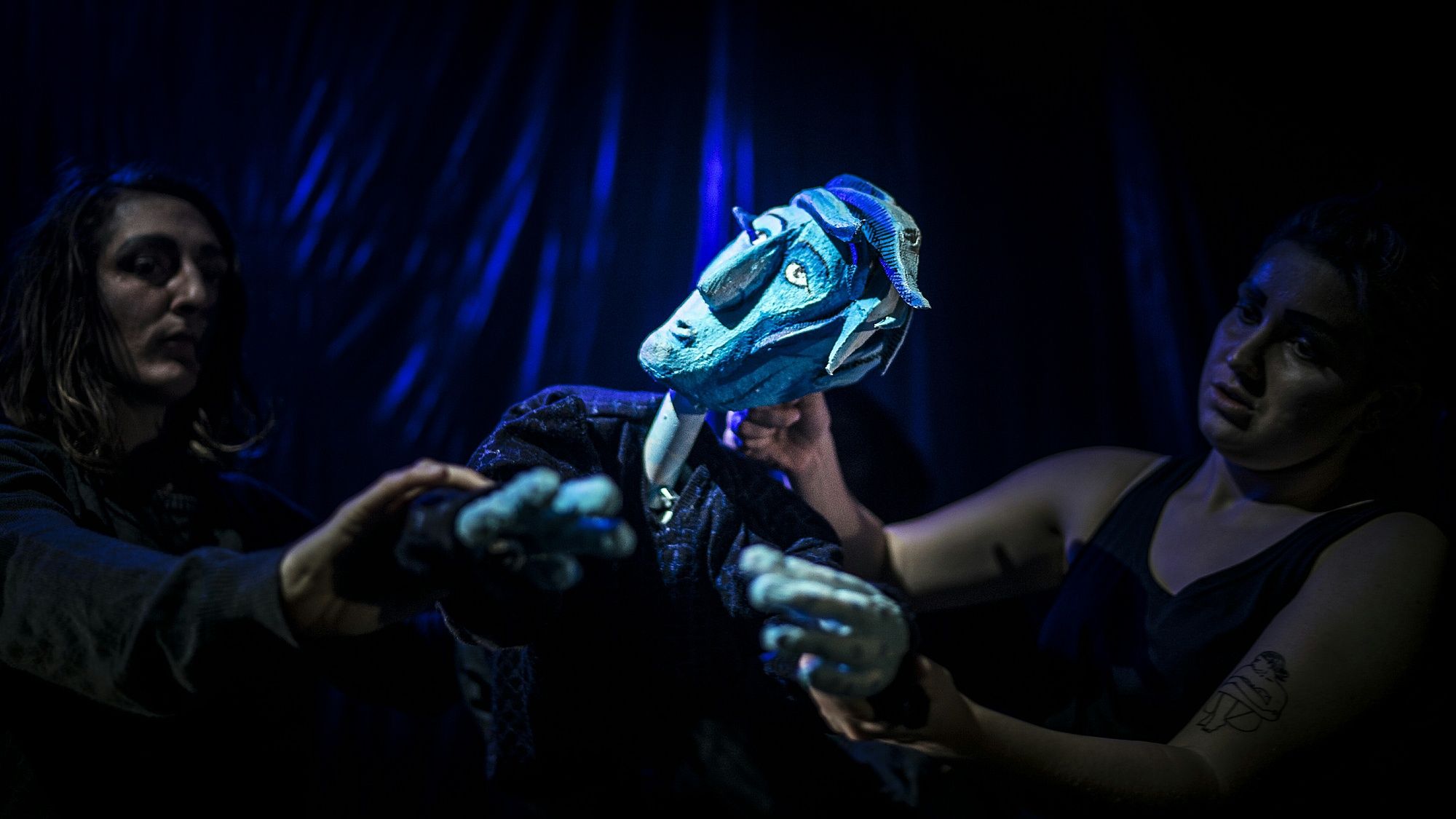The Plastic Heart of the Modern Mariner
Shannon Friday reviews PlayGround Collective's latest production, The Rime of the Modern Mariner, a reimagining of a graphic novel that reimagines Samuel Taylor Coleridge's nightmarish, centuries-old Romantic poem, and considers the weight of the conversation it's entering.
PlayGround Collective's latest production, The Rime of the Modern Mariner, reimagines a graphic novel that reimagines Samuel Taylor Coleridge's nightmarish, centuries-old Romantic poem. Shannon Friday reviews the adaptation at BATS Theatre and considers the weight of the conversation it's entering.
In preparation for this show, I reread Coleridge’s The Rime of the Ancient Mariner. I barely remembered it as a creepy old sailor’s rhymed confession of his greatest personal sin: killing a friendly albatross that led him and his shipmates out of a storm. His shipmates, originally cool with the killing of this Christ symbol, decide he did a “hellish thing” after they’re all becalmed in the South Pacific. They all die of thirst; the Mariner realises he was wrong; the literal skeleton crew help the Mariner drift back to civilization. It's a message about hubris and redemption through suffering.
In 2011, Nick Hayes transformed this Christian allegory into The Rime of the Modern Mariner, a graphic novel about the dangers of our collective environmental hubris. Both the poem and the comic book keep the framing device of an old dude cornering strangers to tell them his story and the basic beats of that story: dead albatross, ship becalmed, redemption for the sailor after witnessing the havoc he’s helped create. But this old man’s audience is a yuppie eating lunch in the park, and Hayes is more cynical than Coleridge: at the end, the yuppie throws his wrapper on the ground and walks home past a store called “Humankind” in the last days of a closing down sale. Where Coleridge wrote a grand metaphor about suffering as atonement for individual hubris, Hayes' graphic novel questions whether redemption is even possible when hubris is so universal.
PlayGround Collective's The Rime of the Modern Mariner, directed by Robin Kerr, drops the old man for Taylor, a plastics engineer who’s a combination of Hayes’ yuppie and Coleridge’s mariner. Taylor’s also a recent widower, as he can’t help but tell all his female colleagues (played by Nikita Tu Bryant, Grace Augustine, Ava Diakhaby and Mary Weir, who all play multiple roles) in a cringe-inducing work drinks montage. There are hints that Taylor wasn’t a good husband or a great father, and there’s a literally throwaway scene where he litters, but the connection between any of his flaws and the ordeal visited on him is tenuous at best. Kerr’s adaptation is unclear about what Taylor’s atoning for or what that atonement might mean; without this clear guiding principle, without building an allegory and letting the audience dig for meaning, Rime drifts along in a beautiful but shallow sea.
Like the blue-toned graphic novel that serves as the show’s inspiration, Modern Mariner is visually stunning and strange. Hayes' illustrations look like they were scratched out of driftwood with a 300-year-old fountain pen, drawing gritty and weathered evocation of the sea's wastes. Sam Trubridge and Jane Hakaraia’s set and lighting design is more reminiscent of a beach just after sunset. Flat rows of translucent white plastic cover half the Heyday Dome’s stage, lit from behind with a strong blue light, an endless, hazy horizon in the confined space, immediately setting an ethereal mood.
Like the blue-toned graphic novel that serves as the show’s inspiration, Modern Mariner is visually stunning and strange.
That design isn’t matched by Modern Mariner’s busyness elsewhere. That cringe-inducing work drinks montage, for example, is cringe-inducing both for Taylor’s torrent of bad pick-up lines and awkward confessions, and for the scene’s clunky use of a variety of theatrical conventions. There’s the disconnected mime that has to be repeated because a scene partner didn’t catch the gesture; the pop-up signs of a text exchange that never show up again and that half the audience can’t read because the typeface is too small; the actors inconsistently playing tables and chairs in one shot, then people in the background in another. It's a stark contrast to the Collective’s All Your Wants and Needs Fulfilled Forever, in which the main character was isolated in a plain white square that covered half the stage, literally walled off from the other humans onstage. That clean choice emphasised his isolating grief. Modern Mariner’s busyness, on the other hand, feels like theatrical experimentation with no clear idea of what that experimentation is meant to communicate. It’s incredibly distracting to whatever the scene is trying to establish.
Perhaps the lack of clear establishing traits, conflicts, and metaphors in the works drinks scene explains why Modern Mariner spends so much time in the scene that follows. In what is essentially another establishing scene, Taylor and three workmates take a boat trip together as a stag do for one of their number. They're full of boisterous energy that borders on cruelty; their pranks range from the juvenile ‘Edward Scrumpyhands’ to tying the prospective bridegroom to the boat’s mast in the blistering sun, a high, piercing white light shining down over the crucified figure.
Like in Coleridge’s poem, things go south after the protagonist shoots an albatross – another stag do game – and the boat is becalmed at sea, in the Great Pacific Garbage Patch. There's something both deeply unsettling and deeply satisfying in the long period that follows the albatross' slaughter, as the four men and the production itself sink into an uneasy lassitude. The four men, initially full of shoving and competition, are drained as their situation worsens, first grasping at each other and swinging weary punches before finally collapsing to the ground. Eventually, the actors morph from one hopeless pile to the other, as changing lights signal the passing of time.
Even here, however, poorly integrated design and acting choices undermine the ebb and flow, the feeling that time is losing meaning and agony is flowing. Coleridge's poem imagines desolation with ghostly images: “water, like a witch's oils” and “slimy things with slimy legs / did crawl upon the sea.” The poem's pulsing rhyme scheme pushes the reader through the images until it feels like we’re trapped in an overwhelming gallery of horror. The comic book furthers that inescapable rush by breaking up its panels with swirling whirlpools and outstretched arms that reach into other images. Here, though, Kerr chops up the action with multiple quiet blackouts or near-blackouts, cutting the story into isolated chunks as the actors push their way through the set, outstretched arms searching for their entrances and exits. Modern Mariner feels like it was made in different stages, actors and designers building apart before identifying ideas to unify their work.
That’s why, when Modern Mariner really works, it’s because the design and action are totally integrated. Late in the play, a series of sea creature puppets, cleverly constructed from waste plastic, swim past Taylor, through and under the Garbage Patch. Luminescent jellyfish made from shopping bags stand out as particularly mesmerising, pulsing and drifting slowly between layers of plastic, long, bedraggled plastic stingers dangling in their wake. They're followed by an undersea parade of creatures from the depths: an elegant whale, a crusty anglerfish, even a drifting body. It's an extraordinary manipulation of materials, both by designers and actors. The creatures flow over the stage and through the foggy area beyond, hinting at all the wonders we can’t see; the materials hint, too, at the intertwining of human and natural worlds.
In these moments, I finally feel like I'm getting a glimpse into the heart of Modern Mariner. Maybe this version doesn't care about atonement for past mistakes. Taylor's transformation from human to plastic puppet implies that it’s too late for humanity and that all we can do is succumb to the consequences of our actions. As he is engulfed by the vortex of garbage, passed by cast-off creatures, I feel incredibly sad for all the things humanity has carelessly thrown away. Including, possibly, us. But then there’s the ending.
Taylor washes up on shore after his drift through the Garbage Patch, human again. He reunites with his daughter in a scene that plays out in slow-motion, drawing particular attention to how long it takes for the girl and her father to reach each other. Their reunion is tender and loving, but Taylor's daughter is played by a very delicate plastic puppet. It’s a choice that confuses the final metaphor: does this artificial puppet-daughter imply that parents have ruined not only the seas, but the generation to follow? Does it mean there’s something more to the moment when Taylor becomes human again? Does it imply that his daughter has also made mistakes in her childhood, and that she will similarly have to suffer before she “earns” her humanity? Or is it just another muddled convention, used because it can be?
By the end of The Rime of the Modern Mariner, I feel oddly drained. I’m unsure what to take away from what I’ve just seen, aside from a kind of awe at what beautiful things designers can make when they are paid and supported properly. In Coleridge’s poem and in Hayes’ graphic novel, the plot drives the reader from one grotesque image to another, a gush of meaning through a unified metaphor. In PlayGround Collective’s three-deep adaptation, the conventions that steer plot and image are unclear at best, undermining any attempt at creating a greater metaphor. Coleridge hailed suffering as a path to redemption. Hayes doubted our ability to learn from past mistakes. PlayGround Collective have something to add to this conversation held across two hundred years, but it’s lost in their beautiful, disjointed story.
The Rime of the Modern Mariner runs at
BATs Theatre, Wellington
from Thursday 10 November to Saturday 26 November
For tickets to and more information about The Rime of the Modern Mariner, go here.
Image credit: Paul McLaughlin.


